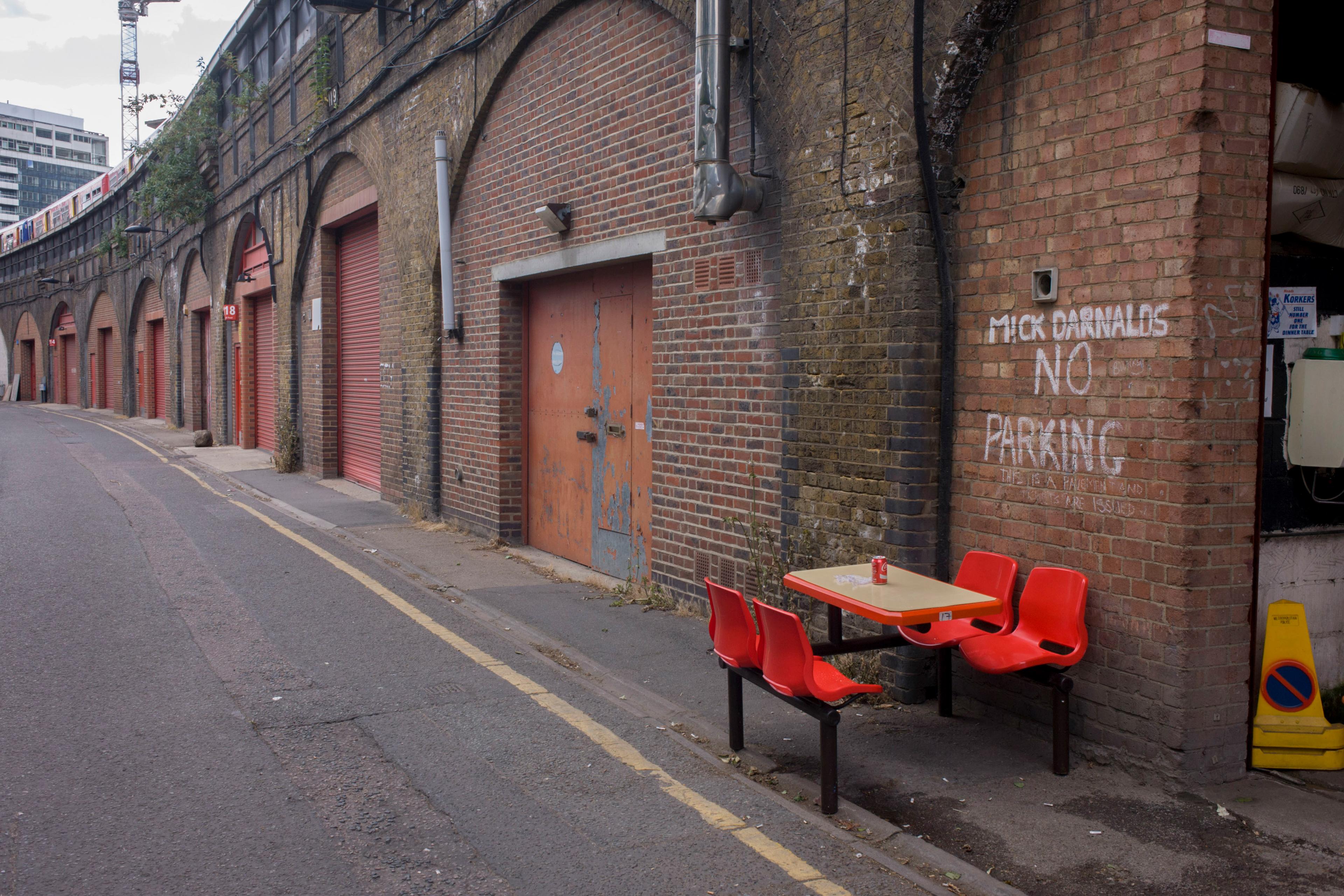Modern institutions make a host of mistakes when they plan out their common spaces. This is especially true of dining halls, cafeterias, canteens – anywhere groups of people who are not quite friends and not quite strangers are going to have to get comfortable enough to eat together. They get the colours, the lighting, the foot-traffic flow and the aesthetic wrong more often than right, and the resulting sterility and discomfort injures the fellowship that could have grown among the diners if they had gotten it right.
Chief among these sins are the little tables. Modern dining spaces commonly offer small, round or rectangular tables, often with four or six chairs. These tables might be scattered about the dining area or, worse, the dining area is cut up into multiple little nooks and crannies with a few tables each. This is done – at least according to the architect’s notes and institutional press releases I have read – in the name of ‘intimacy’ or ‘privacy’ or ‘approachability’, based on the presupposition that the wilting violets who will dine at these tables need to feel as if they are sitting somewhere small if they are to feel comfortable enough to take their meal there. I do not know where this perception came from, but I do know that it is wrong.
This might seem a trivial matter to get worked up over, but it is not. We live in an era of burgeoning social isolation that harms the mental and spiritual wellbeing of individuals and undermines the harmonious functioning of institutions. Too many of us do not know or empathise with the people whom we need to know and empathise with. And dining areas provide one of the best opportunities to do this regularly.
So, what’s the alternative to little tables? I have learned that there is nothing more community oriented and uplifting than a long, continuous dining table – 10, 20 or even more chairs to the side, running the full length of the dining space, forcing everyone to sit alongside each other.
In the Refectory at Graduate House, at St Paul’s College in Sydney, we have three long dining tables that seat 25 people each – 12 to a side plus one at the ‘foot’. There is no ‘head’ chair because we also have a High Table at the ‘head’ end of the hall, which only gets used at our weekly Formal Dinner. The rest of the week, the three long tables are where I, the academics and the students take our meals informally after collecting them from the adjacent servery.
When you arrive at informal dinner, you have precisely no choice where or with whom you sit
When Graduate House first opened, the diagrams of the Refectory originally showed 10 short rectangular tables, evenly dispersed through the room. When the tables were delivered, I promptly asked that they be set up in the positively ancient High-Table-by-three-long-tables arrangement, and we have kept them steadfastly so ever since. Why? So that we can follow the ‘club room rule’: you take the next seat, and no one eats alone.
At the beginning of every year, I give an introductory talk about the rules and regs and the conventions of the House, and I give it in the Refectory. There, I explain the club room rule: when you arrive at informal dinner, you have precisely no choice where or with whom you sit. Instead, you take your plate, head to the first of the long tables, and sit in the westmost open seat. Over the course of the service, the table fills up from west to east, and any gaps fill as previous diners finish and depart. No one sits at the second table unless the first is completely full. Finally, if you see anyone sitting alone at a different table, it is the responsibility of every member of the house to trot right over and sit opposite them with a beatific smile, and either eat there or drag them over to the communal table.
The consequence of this system is that it takes only a week or two for everyone in the House to have dined alongside nearly everyone else, and this means that the naturally intimidating task of sitting next to someone new at dinner is both undermined at the start, and entirely trivial by week three.
While I firmly encourage the club room rule if you can implement it, just having the long, unbroken tables is nine-tenths of the battle. In my experience, once you have these, people tend to loosely follow the rule anyway. Filling a room with long, continuous tables, instead of smaller, broken-up tables, simply makes it less convenient to find a seat that is separated from other people.
This is the great virtue of the long table for building community. People use phrases like ‘breaking bread together’ to mean coming to a closer and more agreeable détente with others, and we should interpret this literally: we can hardly have our guard up when demolishing a second chicken schnitzel in close quarters. Most importantly, the long tables undermine cliques and reduce loneliness. I think every person who has ever had to stomach the challenge of walking into a new cafeteria and choosing a seat has heard the siren call of the empty little table in the corner. It’s so easy. It risks no chance of embarrassment. And yet, neither does the westmost empty seat at the crowded table of strangers, because that is where we sit. Similarly, the tight group of five close friends hip-deep in their inside jokes and gossip are just going to have to grin and bear having 20 neighbouring diners – the cool kids’ table is not a choice they have before them. It’s really very relieving.
These salutary effects of a long table have been seemingly forgotten in many modern institutions, and it is to their detriment. It undermines the unity of spirit that should exist in a school, university or workplace. When I worked in Oxford, I was lucky enough to have had Senior Common Room privileges at two different colleges. In one, we had two long tables that abided by the club room rule. In the other, there were six small tables, with the only convention being not to start a new table if it could be avoided. In the first, I felt welcome every time. When I sat down, those whom I did not yet know were always immediate in their introduction and efforts to include me in the conversation. In the other, friendly though everyone was, one tended to act strategically, coming into lunch and sitting with those one already knew. When unintroduced members ended up beside each other, it often led to no conversation beyond a polite hello. Both were pleasant places, but the collegiality of the first was better, and I would argue that the tables had something to do with this.
The long table is an essential tool for rebuilding ‘third places’
Let not these ivory towers suggest, however, that the virtue of long tables applies only in dining places exclusive or ancient. If you are running a café, a restaurant, a wedding breakfast or just a big family gathering, you can expect the same benefits. Some people who go to trendy cafés lament getting stuck at the long central table that has to be shared, instead hoping they get a ‘private’ table. But that is foolish. On a recent trip to see family, I got stuck at the big table in a café, too; I ended up making a new friend there and learning about the surrounding town.
The long table is an essential tool for rebuilding the ‘third places’ – communal places that are neither home nor the workplace – that are too often missing from people’s highly private 21st-century lives. They are a physical antidote to loneliness. Cafés and restaurants should provide them and patrons should demand them.
In the collection of essays titled Heretics (1905), G K Chesterton wrote that:
The man who lives in a small community lives in a much larger world. He knows much more of the fierce varieties and uncompromising divergences of men. The reason is obvious. In a large community we can choose our companions. In a small community our companions are chosen for us.
The trouble with typical round or square tables is that they provide exclusion zones in which one chooses one’s own companions from the larger community. The long tables, insofar as they lay out various members of a community before each person, make even a large community feel more like a small one. They force each member to embrace the possibility of concord with each other, regardless of their ‘fierce varieties’ or ‘uncompromising divergences’.
It is the natural way for a large group of people to eat
As an aside – big round tables don’t work. The whole table often feels obligated to a single, large conversation, in which pedestrian blowhards can dominate the chat while everyone else tries to keep up the appearance of respectability. A long table, in contrast, places several potential conversants opposite each diner as well as the two on each side, and so it creates numerous, small domains of conversation that are not private but are limited in size. These can change in shape and number as conversation and overhearing dictates, and provide a small-enough sphere in which to say something interesting or unusual.
Importantly, the users of our spaces in College have confirmed these principles again and again. There are a couple of other places where my students at Graduate House regularly eat together. In one such area, a rooftop terrace with three rectangular tables, the students have dragged the tables into one long one, so that they can abide by the club room rule even where it has never been enforced. It is the natural way for a large group of people to eat. It is comforting and community minded. It lets every day become a feast.
So, if you have the opportunity to make a decision about how people will sit down together, or to influence the decision, or to complain about the decision – seize it. Reject the little tables. Embrace the long. Make every meal a banquet, and watch your community flourish.








